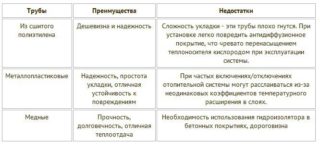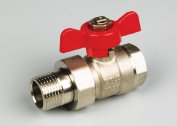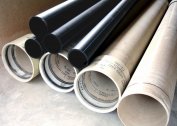Installation of the water supply system must be carried out in accordance with the established standards. In this case, special attention is paid to the choice of pipes. Their technical characteristics provide long-term operation of communication in various conditions (hot / cold water supply, heating, etc.). More often, masters prefer metal-plastic or polypropylene pipes for water supply. Both materials have a number of characteristic features.
Comparative analysis of water pipes made of metal-plastic and polypropylene
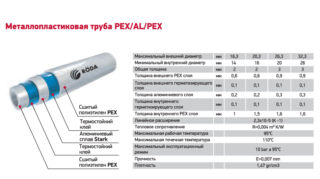 Before buying a particular type of pipe, it is important to understand their strengths, weaknesses, capabilities.
Before buying a particular type of pipe, it is important to understand their strengths, weaknesses, capabilities.
Specifications
Due to their structure (plastic / glue / aluminum foil / glue / plastic), pipes made of metal polymer have the following capabilities:
- permissible maximum temperature of transported media is +110 degrees;
- the length of one pipe cut from 50 to 200 mm - this gives the master the opportunity to mount the system with fewer connections and fittings;
- working pressure - 10 Atmospheres at a temperature of +95 and 25 Atmospheres at indicators up to +25;
- high thermal conductivity, which is especially good when installing a heating system in the house;
- long term of operation - provided that metal-plastic is correctly installed on cold water, it serves more than 50 years, on hot water - up to half a century;
- good ductility - permissible level of bending up to 90 degrees.
The tubes have a perfectly smooth surface of the inner walls, which prevents clogging and siltation of the communication.
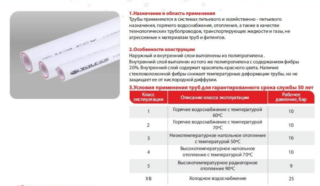 Polypropylene has the following specifications:
Polypropylene has the following specifications:
- Maximum working temperature of the pumped-over medium - +95 degrees;
- service life - 25 years for a hot water supply system and from 50 years for cold water supply;
- working pressure - 25 atm at temperatures up to +25 degrees, 7 atm at indicators from +25 to +95 degrees;
- high-quality reinforcement of pipes, which allows you to lay them under the tile in the bathroom.
Polypropylene tubes are afraid of ultraviolet radiation, so they are suitable only for interior use. Do not use them at a constant room temperature below 0.
Assembly and connection
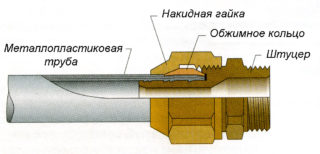 When communicating, it is important to consider the installation (docking) features of both types of pipes. Metal-plastic is joined using crimp or screw press fittings. In the first case, the joint will be one-piece. In the second, the system is subject to possible disassembly and replacement of its section. When using a crimp press fitting, it is possible to achieve the most tight connection. But to use such parts you need a special tool. The finished pipeline, joined with crimp fittings, can be embedded in concrete. When using screw fittings, it is not recommended to remove the pipes by the sheathing.
When communicating, it is important to consider the installation (docking) features of both types of pipes. Metal-plastic is joined using crimp or screw press fittings. In the first case, the joint will be one-piece. In the second, the system is subject to possible disassembly and replacement of its section. When using a crimp press fitting, it is possible to achieve the most tight connection. But to use such parts you need a special tool. The finished pipeline, joined with crimp fittings, can be embedded in concrete. When using screw fittings, it is not recommended to remove the pipes by the sheathing.
In any case, when the temperature and pressure drops in the system, the metal plastic undergoes expansion / contraction. This over time leads to a weakening of fittings. As a result, there may be a leak in the joints and leaks.
Installation of polypropylene is performed by soldering. The process is simple, even a layman will cope with it. The main thing is to get a special soldering iron with nozzles of the right size. Soldered joints have increased tightness. Turns in the system are formed using special fittings-adapters.
Operation and repair
It is better to operate metal-plastic pipes in such conditions:
- warm rooms with a temperature of +5 degrees;
- fire hazardous facilities;
- one type of system (or only cold water / hot water, or heating system) - if the plastic is exposed to temperature fluctuations from the inside, its life is reduced by three to four times.
It is also important to remember that icing in the system can lead to pipe rupture. As for the maintainability of the metal polymer, in case of failure of one tube or connection, it will be necessary to change the entire communication, since the tubes change their plasticity over time over the entire length.
Polypropylene pipes can not be operated in such conditions:
- open sun;
- subzero temperatures;
- objects with high fire hazard.
In case of failure of the PP pipe (which happens extremely rarely), you can simply replace the deformed section without having to change the entire communication.
Advantages and disadvantages
The main positive aspects of metal-plastic pipes are:
- Moderate ease of installation. Work can be performed even without special skills.
- Plasticity of the material. Pipes are flexible.
- The internal smoothness of the walls, which is maintained regardless of the transported medium and its temperature.
- High level of thermal conductivity due to the foil layer.
Cons of metal polymer:
- a small range of sections (from 16 to 63 mm);
- relative fragility of the material - lack of resistance to shock loads, ultraviolet;
- tendency to tear when freezing;
- risk of weakening of joints during temperature fluctuations;
- the relative high cost of the pipes themselves and fittings for mounting the system.
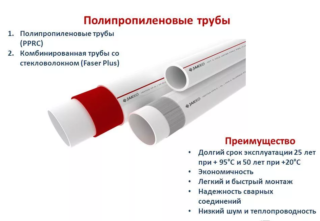 Polypropylene has the following positive properties:
Polypropylene has the following positive properties:
- increased wear resistance: shock, mechanical stress does not harm the polymer;
- the integrity of the polypropylene structure is not violated over time due to the reinforcing fiber - no delamination is observed;
- the plasticity of the polymer allows it to expand / contract many times under the influence of the temperature of the transported media and again return to its original state without the risk of deformation;
- inertness to aggressive environments - polypropylene can be put on the line for transportation of compounds with an admixture of acids;
- the ability to hide communication under the tile, behind drywall, in concrete.
A minus of propylene is its inability to bend during installation. Experienced craftsmen easily circumvent this problem with the help of special rotary fittings. Under the influence of ultraviolet light, polypropylene collapses with time, therefore, it is not used for outdoor work.
Which pipes are better for water supply
If we take into account all the technical characteristics of both materials, take into account the positive and negative points, the conclusion is as follows:
- Plastic pipes - a good option for a heating system. The structure of the metal polymer will give off heat to the room. In addition, the operation of the material at a constant temperature extends its life.
- Polypropylene pipes are as good as possible for the installation of a water supply system in a house or apartment / cottage, but not on the street.
For the correct installation of the water supply or heating system, it is better to use the services of a professional master. Accurate docking extends the life of the system. The tightness of the pipeline in the hands of the master will be the best.
